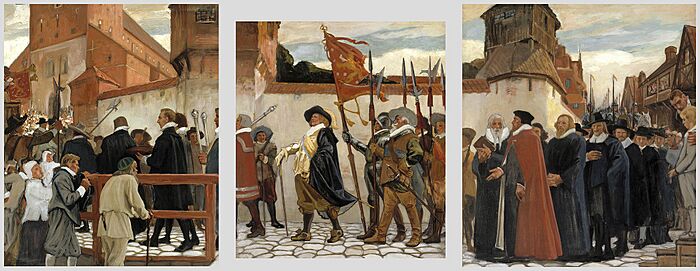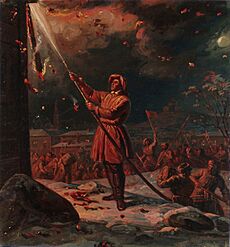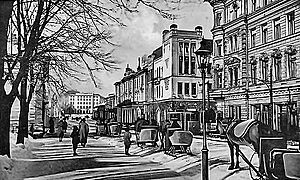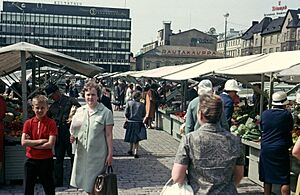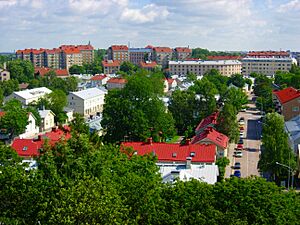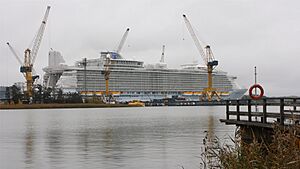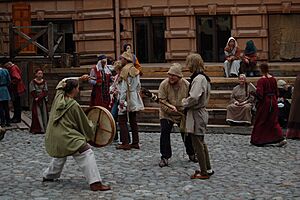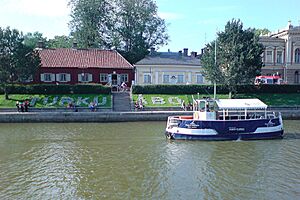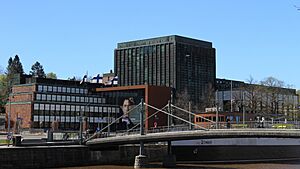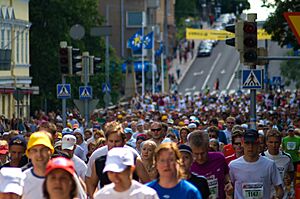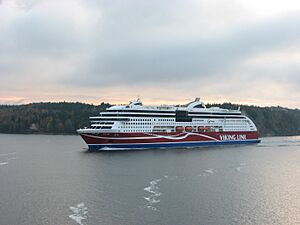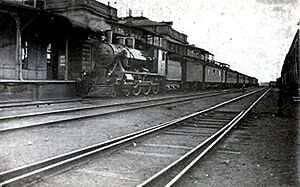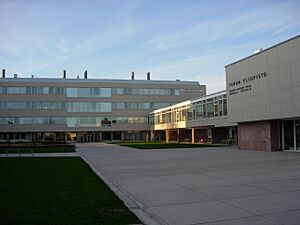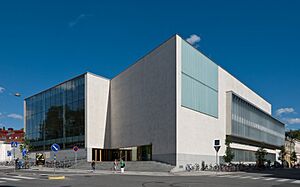Turku facts for kids
Quick facts for kids
Turku
Åbo (Swedish)
|
|||
|---|---|---|---|
|
City
|
|||
| Turun kaupunki Åbo stad City of Turku |
|||
|
Top row: aerial view of Turku from atop Turku Cathedral
2nd row: Turku Castle; Flag of Turku; Tall Ships Races in Turku 3rd row: The Christmas Peace Balcony of Turku; Turku Cathedral; Turku Medieval Market Bottom row: summer along the Aura River; view of Yliopistonkatu pedestrian area |
|||
|
|||
| Nickname(s):
Paris of Finland, Food Capital of Finland
|
|||
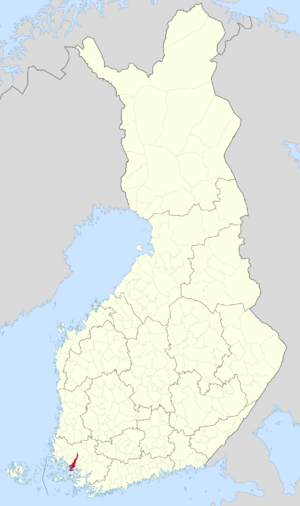
Location of Turku in Finland
|
|||
|
OpenStreetMap
Interactive map outlining Turku.
|
|||
| Country | |||
| Region | Southwest Finland | ||
| Sub-region | Turku sub-region | ||
| Metropolitan area | Turku metropolitan area | ||
| First historical record | 23 January 1229 | ||
| First possible appearance on map | 1154 | ||
| Capital city | 17 September 1809 – 8 April 1812 | ||
| Area | |||
| • City | 306.36 km2 (118.29 sq mi) | ||
| • Land | 245.63 km2 (94.84 sq mi) | ||
| • Water | 60.7 km2 (23.4 sq mi) | ||
| • Metro | 1,185.24 km2 (457.62 sq mi) | ||
| Area rank | 247th largest in Finland | ||
| Population
(2023-12-31)
|
|||
| • City | 201,863 | ||
| • Rank | 6th largest in Finland | ||
| • Density | 821.82/km2 (2,128.5/sq mi) | ||
| • Metro | 310,605 | ||
| Population by native language | |||
| • Finnish | 79.3% (official) | ||
| • Swedish | 5.4% (official) | ||
| • Others | 15.3% | ||
| Population by age | |||
| • 0 to 14 | 12.6% | ||
| • 15 to 64 | 66.5% | ||
| • 65 or older | 20.9% | ||
| Time zone | UTC+02:00 (EET) | ||
| • Summer (DST) | UTC+03:00 (EEST) | ||
| Postal code |
20000–20960
|
||
Turku is a city in Finland and the main city of Southwest Finland. It is located on the southwestern coast, right where the River Aura meets the sea. About 200,000 people live in Turku. The wider area, including nearby towns, has around 330,000 residents. This makes Turku the third largest urban area in Finland.
Turku is Finland's oldest city. We don't know the exact year it became a city. But, a letter from Pope Gregory IX in 1229 mentioned a town called Aboa. So, 1229 is now seen as the year Turku was founded. Turku was once the most important city in the eastern part of the Kingdom of Sweden, which is now Finland.
After the Finnish War in 1809, Finland became part of the Russian Empire. Turku then became the capital of this new area, called the Grand Duchy of Finland. However, Turku was only the capital for three years. In 1812, Tsar Alexander I of Russia moved the capital to Helsinki. After a huge fire in 1827, many government offices and the old university moved to Helsinki. This made Helsinki the clear new capital.
Even though it's not the capital anymore, Turku is still a very important city. It's a big business and cultural center. It also has a busy port. Turku was the European Capital of Culture in 2011, along with Tallinn in Estonia. It's also known as the "Christmas City" of Finland. People call Turku the "Food Capital of Finland" because it has many old and great restaurants. Its café culture is often compared to French food, earning it the nickname "Paris of Finland."
Turku is a bilingual city. This means both Finnish and Swedish are official languages. Most people speak Finnish, but a good number also speak Swedish. Because of its location, the Port of Turku is a very important port. Over three million passengers travel from here to Stockholm and Mariehamn every year.
Contents
Discovering Turku's Names and History
What Do the Names Turku and Åbo Mean?
The Finnish name Turku comes from both Sweden and Russia. It's linked to an old word meaning "market" or "trading place." This word came into Finnish and slowly became the name of the city.
The Swedish name Åbo might simply mean "river dwelling." It combines å (river) and bo (dwelling). There's also an old legal term related to living on land owned by the king.
In Finnish, "Turun" means "of Turku." You'll often see this word at the start of names for organizations in the city. For example, the University of Turku is called Turun yliopisto.
A Look Back at Turku's Past
Turku has a long and rich history. It was Finland's largest city for a long time. It even served as the country's main administrative center sometimes. Turku is known as the oldest city in Finland and was its first capital. The word "Finland" originally only referred to the area around Turku.
Early Settlements and First Records
People started living in the Turku area later than other parts of Finland. This is because the land was under the sea after the Ice Age. Over time, the land rose, and the area became a shoreline. During the Iron Age, this region was very populated. It was an important farming area. Old burial sites from 550 to 1150 have been found here.
Legends say that an English bishop named Henry brought Christianity to Finns in 1150. However, the first Christian graves are even older, from the 10th and 11th centuries. The first signs of a church date back to the 12th century. By the 11th century, Turku was growing as a port. An old map from 1154 also mentions Turku.
Turku During the Swedish Era
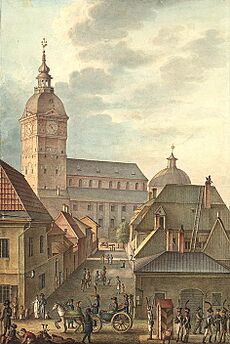
In 1229, the main church office moved to Koroinen, near today's Turku. This suggests there was already a village there. The city of Turku itself might have been founded later, in the 1280s or 1290s. This was likely a joint effort by the king, the bishop, and a church group called the Dominicans.
Turku Cathedral was finished in 1300. During the Middle Ages, Turku was the seat of the Bishop. This bishop oversaw most of what is now Finland. Turku was also a key city for trade with the Hanseatic League. Many German traders lived there.
In the early 1500s, the Danes attacked Turku twice. But in 1523, Erik Fleming's troops drove them out. After this, Gustav Vasa became king. He visited Turku Castle and brought the reformation (a change in religion). Mikael Agricola, known as the "father of Finnish literary language," became the Bishop of Turku.
Later, Duke John, son of Gustav Vasa, ruled Finland from Turku Castle. In 1640, the first university in Finland, the Royal Academy of Turku, was founded in Turku. This was ordered by Queen Christina and supported by Count Per Brahe.
Turku Under Russian Rule
In 1809, after the Finnish War, Sweden gave Finland to Imperial Russia. The Russians marched into Turku peacefully. Life continued as usual, and leaders swore loyalty to the new Russian ruler.
Turku was briefly the official capital. But Emperor Alexander I soon moved the capital to Helsinki in 1812. He felt Turku was too close to Sweden. After the Great Fire of Turku in 1827, most government offices moved to Helsinki. A new, safer city plan was designed by Carl Ludvig Engel. Turku remained Finland's largest city for another twenty years.
By the mid-1800s, Turku was an important city for crafts. The Industrial Revolution came to Turku around 1900. The First World War boosted the city's industries.
Turku After Finland's Independence
In 1918, a new university, the Åbo Akademi, was founded in Turku. It is the only Swedish-language university in Finland. Two years later, the Finnish-language University of Turku was also founded. Both were started with private donations.
In the 20th century, Turku was called "Finland's gateway to the West." It had strong connections with other European countries. In the 1960s, Turku was the first Western city to partner with Leningrad (now St. Petersburg) in the Soviet Union. This led to more cultural exchange. After communism ended, many people from Russia came to Turku to learn about Western business.
Turku's buildings and way of life changed a lot in the 20th century. Many old wooden houses were torn down in the 1950s and 1960s. This made way for new apartments and roads for cars. Some of these demolitions are still debated today, as many beautiful old buildings were lost.
Exploring Turku's Geography
Turku is located at the mouth of the Aura River. The city covers an area of 245 square kilometers. It sits on both sides of the river. The eastern side, with Turku Cathedral, is the older part. The western side, with Turku Castle, is newer. Today, both sides are equally important city centers.
There are ten bridges over the Aura River. The oldest, Auransilta, was built in 1904. The newest is Kirjastosilta, a bridge just for people walking. A small ferry called the Föri carries people and bikes across the river for free. It's a famous part of the city.
City Areas and Islands
Turku is divided into 78 districts and nine larger areas called wards. These are not local governments. But some social programs are based on these districts. The biggest districts by population are Varissuo and Runosmäki. By size, Kakskerta and Paattinen are the largest.
Many smaller towns near Turku joined the city in the mid-1900s. This makes Turku shaped like a long pear. The city center is in the middle. Islands like Ruissalo, Hirvensalo, and Kakskerta form the southern part of the city. These islands are less crowded and have many summer homes.
Understanding Turku's Climate
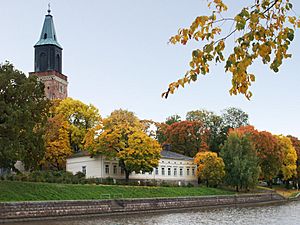
Turku has a humid continental climate. This means it has warm summers and cold, snowy winters. Summer temperatures can reach up to 30°C (86°F). The warmest month is July, with an average of 17.5°C (63.5°F). February is the coldest. Winter usually starts in early December, and spring in late March.
Turku gets about 720 millimeters (28 inches) of rain each year. August is the rainiest month. April is the driest. The sea helps keep winter temperatures milder in the city compared to the airport. This also helps oak, maple, and ash trees grow well near the coast.
| Climate data for Turku Airport (elevation 47 m) 1991-2020 normals, extremes 1900- present | |||||||||||||
|---|---|---|---|---|---|---|---|---|---|---|---|---|---|
| Month | Jan | Feb | Mar | Apr | May | Jun | Jul | Aug | Sep | Oct | Nov | Dec | Year |
| Record high °C (°F) | 9.2 (48.6) |
10.2 (50.4) |
15.8 (60.4) |
24.5 (76.1) |
30.0 (86.0) |
32.0 (89.6) |
35.9 (96.6) |
33.0 (91.4) |
27.8 (82.0) |
18.9 (66.0) |
14.1 (57.4) |
11.0 (51.8) |
35.9 (96.6) |
| Mean daily maximum °C (°F) | −1.1 (30.0) |
−1.2 (29.8) |
2.6 (36.7) |
9.1 (48.4) |
15.5 (59.9) |
19.5 (67.1) |
22.6 (72.7) |
21.1 (70.0) |
15.7 (60.3) |
8.8 (47.8) |
3.6 (38.5) |
0.7 (33.3) |
9.7 (49.5) |
| Daily mean °C (°F) | −3.8 (25.2) |
−4.5 (23.9) |
−1.3 (29.7) |
4.1 (39.4) |
10.0 (50.0) |
14.4 (57.9) |
17.5 (63.5) |
16.2 (61.2) |
11.3 (52.3) |
5.7 (42.3) |
1.5 (34.7) |
−1.5 (29.3) |
5.8 (42.5) |
| Mean daily minimum °C (°F) | −6.5 (20.3) |
−7.1 (19.2) |
−4.7 (23.5) |
−0.2 (31.6) |
4.6 (40.3) |
9.3 (48.7) |
12.5 (54.5) |
11.6 (52.9) |
7.4 (45.3) |
2.8 (37.0) |
−0.9 (30.4) |
−4.1 (24.6) |
2.1 (35.8) |
| Record low °C (°F) | −35.5 (−31.9) |
−35.2 (−31.4) |
−32.8 (−27.0) |
−21.0 (−5.8) |
−6.6 (20.1) |
−2.2 (28.0) |
1.8 (35.2) |
0.2 (32.4) |
−6.9 (19.6) |
−15.0 (5.0) |
−22.3 (−8.1) |
−33.8 (−28.8) |
−35.5 (−31.9) |
| Average precipitation mm (inches) | 58 (2.3) |
42 (1.7) |
39 (1.5) |
32 (1.3) |
35 (1.4) |
55 (2.2) |
74 (2.9) |
73 (2.9) |
59 (2.3) |
73 (2.9) |
71 (2.8) |
73 (2.9) |
684 (27.1) |
| Average precipitation days | 11 | 9 | 8 | 7 | 7 | 8 | 8 | 10 | 9 | 11 | 13 | 12 | 113 |
| Mean monthly sunshine hours | 40 | 75 | 134 | 204 | 284 | 276 | 287 | 230 | 155 | 89 | 38 | 27 | 1,839 |
| Source: Climatological statistics for the normal period 1991–2020 | |||||||||||||
| Climate data for Turku Artukainen (elevation 8 m) averages and records 2003-2023, precipitation 2003-2005 Turku Airport, since 2006 Artukainen, sunshine 1991-2020 | |||||||||||||
|---|---|---|---|---|---|---|---|---|---|---|---|---|---|
| Month | Jan | Feb | Mar | Apr | May | Jun | Jul | Aug | Sep | Oct | Nov | Dec | Year |
| Record high °C (°F) | 9.2 (48.6) |
9.4 (48.9) |
15.0 (59.0) |
23.9 (75.0) |
29.4 (84.9) |
31.6 (88.9) |
33.6 (92.5) |
33.0 (91.4) |
28.0 (82.4) |
17.5 (63.5) |
14.1 (57.4) |
10.6 (51.1) |
33.6 (92.5) |
| Mean maximum °C (°F) | 5.3 (41.5) |
4.7 (40.5) |
11.0 (51.8) |
17.5 (63.5) |
25.2 (77.4) |
26.5 (79.7) |
28.7 (83.7) |
27.1 (80.8) |
21.5 (70.7) |
14.9 (58.8) |
10.0 (50.0) |
6.7 (44.1) |
28.7 (83.7) |
| Mean daily maximum °C (°F) | −0.8 (30.6) |
−0.6 (30.9) |
3.1 (37.6) |
9.6 (49.3) |
16.1 (61.0) |
20.5 (68.9) |
23.3 (73.9) |
21.7 (71.1) |
16.4 (61.5) |
9.6 (49.3) |
4.9 (40.8) |
1.6 (34.9) |
10.5 (50.8) |
| Daily mean °C (°F) | −3.5 (25.7) |
−3.6 (25.5) |
−0.6 (30.9) |
4.8 (40.6) |
10.9 (51.6) |
15.5 (59.9) |
18.6 (65.5) |
17.3 (63.1) |
12.5 (54.5) |
6.6 (43.9) |
2.7 (36.9) |
−0.8 (30.6) |
6.7 (44.1) |
| Mean daily minimum °C (°F) | −6.2 (20.8) |
−6.5 (20.3) |
−4.4 (24.1) |
0.1 (32.2) |
5.7 (42.3) |
10.4 (50.7) |
13.8 (56.8) |
12.9 (55.2) |
8.6 (47.5) |
3.5 (38.3) |
0.5 (32.9) |
−3.3 (26.1) |
2.9 (37.3) |
| Mean minimum °C (°F) | −18.3 (−0.9) |
−15.2 (4.6) |
−13.6 (7.5) |
−6.2 (20.8) |
−1.7 (28.9) |
4.1 (39.4) |
8.5 (47.3) |
6.6 (43.9) |
1.3 (34.3) |
−4.5 (23.9) |
−7.5 (18.5) |
−12.8 (9.0) |
−18.3 (−0.9) |
| Record low °C (°F) | −25.4 (−13.7) |
−25.4 (−13.7) |
−20.4 (−4.7) |
−9.9 (14.2) |
−3.7 (25.3) |
−0.3 (31.5) |
4.5 (40.1) |
3.3 (37.9) |
−1.3 (29.7) |
−12.6 (9.3) |
−18.6 (−1.5) |
−23.4 (−10.1) |
−25.4 (−13.7) |
| Average precipitation mm (inches) | 55 (2.2) |
38 (1.5) |
31 (1.2) |
30 (1.2) |
39 (1.5) |
45 (1.8) |
70 (2.8) |
84 (3.3) |
55 (2.2) |
71 (2.8) |
70 (2.8) |
76 (3.0) |
664 (26.3) |
| Average rainy days (≥ 1 mm) | 11 | 8 | 8 | 7 | 7 | 8 | 9 | 11 | 9 | 12 | 12 | 13 | 115 |
| Mean monthly sunshine hours | 40 | 67 | 141 | 205 | 284 | 283 | 293 | 239 | 163 | 88 | 34 | 24 | 1,861 |
| Source 1: Finnish Meteorological Institute | |||||||||||||
| Source 2: https://www.ilmatieteenlaitos.fi/1991-2020-auringonpaiste-ja-sateilytilastot | |||||||||||||
Understanding Turku's Population
Who Lives in Turku?
Turku has about 200,000 people. This makes it the sixth most populated city in Finland. The larger Turku area, including nearby towns, has about 330,000 people. This makes it the third largest region in Finland. About 4% of all people in Finland live in Turku.
About 15.6% of Turku's population has a foreign background. This is almost twice the national average for Finland. The average age in Turku is 42.1 years, which is a bit younger than the national average.
| Year | Population |
|---|---|
| 1980 |
163,933
|
| 1985 |
162,379
|
| 1990 |
159,180
|
| 1995 |
164,744
|
| 2000 |
172,561
|
| 2005 |
174,868
|
| 2010 |
177,326
|
| 2015 |
185,908
|
| 2020 |
194,391
|
What Languages Are Spoken in Turku?
Population by mother tongue (2023) Finnish (79.3%) Swedish (5.4%) Russian (1.8%) Arabic (1.7%) Albanian (1.2%) Kurdish (1.2%) Somali (0.9%) Other (8.6%)
Turku is officially bilingual, meaning it has two official languages: Finnish and Swedish. Most people, about 79.3%, speak Finnish as their first language. About 5.4% of the population speaks Swedish. Since English and Swedish are taught in schools, many people can speak three languages.
About 15.3% of Turku's population speaks a language other than Finnish or Swedish as their first language. People from over 130 countries live in Turku. The most common foreign languages are Russian, Arabic, Albanian, Kurdish, and Somali.
Immigration in Turku
| Population by country of birth (2022) | ||
| Nationality | Population | % |
|---|---|---|
| 173,263 | 87.6 | |
| 2,502 | 1.3 | |
| 2,300 | 1.2 | |
| 1,618 | 0.8 | |
| 1,244 | 0.6 | |
| 1,225 | 0.6 | |
| 1,164 | 0.6 | |
| 985 | 0.5 | |
| 624 | 0.3 | |
| 551 | 0.3 | |
| 547 | 0.3 | |
| Other | 12,188 | 5.9 |
In 2023, about 31,589 people in Turku had a migrant background. This is 15.6% of the population. About 28,002 residents were born outside Finland. The number of foreign citizens was 19,062.
Turku has a higher percentage of immigrants than the national average. More new residents are coming from other countries. This means the number of foreign residents will keep growing. Most foreign-born people in Turku come from the former Soviet Union, Iraq, Estonia, Sweden, and the former Yugoslavia.
Religion in Turku
In 2023, the Evangelical Lutheran Church was the largest religious group. About 56.3% of Turku's people belonged to it. Other religious groups made up 3.3% of the population. A large part of the population, 40.4%, did not belong to any religious group.
Turku's Economy and Culture
How Does Turku Make Money?
The Turku area has 22,000 businesses. It also has two universities and four polytechnic schools. The city is strong in shipping, life sciences, information technology, and biotechnology. The Port of Turku and other service industries are key to the city's economy.
Meyer Turku shipyard is the biggest industrial employer. It builds large ships, like the Oasis of the Seas. Turku also has a high-tech area called Turku Science Park. This area is growing in IT and biotechnology.
Many big Finnish companies have their main offices in Turku. These include HKScan (food) and Hesburger (fast food). Other large companies like Bayer and Wärtsilä also have operations here.
Experiencing Turku's Culture
Turku has many cultural places. These include museums, theaters, cinemas, and art galleries. The city hosts many cultural events. The most important is the declaration of Christmas Peace on December 24th. This tradition is about 700 years old.
Other popular events include the Medieval Market, the Music Festival, and the Ruisrock rock festival. Turku was the European Capital of Culture in 2011. The city has worked hard to improve its image for this honor.
Old Buildings to Explore

Turku began to be built in the late 1200s. But only a few old buildings remain. This is because of the Great Fire of Turku in 1827. That fire destroyed three-quarters of the city.
Turku Cathedral, built in the 13th century, is one of the oldest buildings still in use. It is Finland's only medieval basilica church. Turku Castle, built in the 1280s, is another old building. Only ruins remain of the bishop's church in Koroinen. Qwensel House, from the 18th century, is the oldest wooden house in Turku. It is now a museum.
Museums to Visit
Most of Turku's museums are along the Aura River. The Turku Art Museum is in a granite castle. It shows both old and new art. Turku Cathedral has a museum about its history. Next to the cathedral is Ett Hem, a 19th-century home, and the Sibelius Museum, with musical instruments.
Aboa Vetus & Ars Nova combines old ruins with modern art. The Luostarinmäki Craftsman Museum shows an 18th-century wooden village. The Pharmacy Museum and Qwensel House is Turku's oldest wooden house. It shows how people lived in the 18th century.
The WAM is a modern art museum. It is named after sculptor Wäinö Aaltonen. The Biological Museum shows Finnish wildlife. Forum Marinum is a maritime museum with old ships. Turku Castle is a popular attraction with over 700 years of history.
Theaters and Music in Turku
Turku has several theaters. The biggest is the Turku City Theatre. It is in the city center by the Aura River. It shows many different plays. Other theaters include Linnateatteri and Åbo Svenska Teater. There are also puppet theaters and summer theaters.
Turku is a great place for music. The Turku Philharmonic Orchestra is the oldest orchestra in Finland. It started in 1790. It plays classical music and performs across Finland.
The city also has many music festivals. Ruisrock is Finland's oldest rock festival. It takes place on Ruissalo island. Aura Fest and DBTL are city festivals along the Aura River. The Turku Jazz festival is in July. The Turku Music Festival in August focuses on classical music.
City Rivalry and Traditions
People in Finland often think of Turku as "old and historic." A society called Turkuseura-Åbosamfundet ry works to preserve Turku's culture and history.
Turku and Tampere have a friendly rivalry. They joke about Tampere's traditional dish, mustamakkara, and Turku's Aura River. Both cities have great food scenes. Students from Tampere visit Turku every year to jump on the market square. This tradition is said to help move the city closer to the Baltic Sea.
Sports and Transportation in Turku
Sports Teams and Events
Turku has two main football teams: FC Inter and TPS. FC Inter plays in the top league. Both teams play at Veritas Stadion.
The HC TPS is an ice hockey team. They play in the top league and have won 11 national championships. Their games are at Gatorade Center.
The city hosts the annual Paavo Nurmi Marathon. It is named after the famous runner Paavo Nurmi, who was born in Turku. Turku also has rugby and lacrosse clubs.
Getting Around Turku

Turku has a good public bus network. It is managed by the Turku City Region's Public Transport Committee (FÖLI). Buses also serve nearby towns. The prices are the same for travel within these areas.
Trains to and from Turku are run by the national company, VR. You can take trains to Tampere and Helsinki. The main train stations are Turku Central railway station, Kupittaa, and the Port of Turku.
Turku used to have trams, but they stopped in 1972. However, there are plans for a new light rail system. Construction might start in 2026. The first route will connect Turku Port to the city center and Varissuo.
Turku has an outdoor inclined elevator called the Funicular. It goes up Kakolanmäki hill. It's free and takes about one minute to travel.
The city is planning a new travel center. It will combine the bus station and central railway station. This center will have a hotel and shops. It will connect all public transport.
Major highways connect Turku to other cities like Helsinki, Tampere, and Pori. The Turku Ring Road goes around the city.
Turku Airport is 8 kilometers north of the city center. Several airlines use it for passenger and cargo flights.
Daily ferry services run from the Port of Turku to Sweden and Åland. These ferry trips are a Finnish tradition. People travel far to take a cruise across the Gulf of Bothnia.
You can also take boat trips in the Archipelago Sea. The old steamship SS Ukkopekka cruises between Turku and Naantali. Turku is the only city in Finland with three long-distance railway stations.
Learning in Turku: Education and Media
Education in Turku
Turku has the longest history of education in Finland. The first school, the Cathedral School, was founded in the late 1200s. Finland's first university, the Royal Academy of Turku, was established here in 1640.
About 40,000 students attend higher education in Turku. There are two universities and several polytechnic schools. The Finnish University of Turku is the fourth largest university in Finland. It was founded in 1920. About 9% of its students are from other countries. Åbo Akademi, founded in 1918, is one of Finland's two Swedish-language universities.
Turku University of Applied Sciences (TUAS) is the second largest polytechnic in Finland. It has about 12,000 students. TUAS offers many Bachelor and Master studies. Other schools like Novia University of Applied Sciences also have campuses in Turku.
Turku is one of only two cities in Finland with an international school. Turku International School opened in 2003. It is located in the eastern district of Varissuo.
Media and News in Turku
The most popular newspaper in Turku is Turun Sanomat. Over 70% of the people read it every day. Åbo Underrättelser, a Swedish-language newspaper, is the oldest newspaper in Finland. It has been published since 1824.
The first Finnish newspaper, in Swedish, started in Turku in 1771. The first Finnish-language newspaper began in 1775.
Turun Sanomat used to have a local TV station, but it stopped in 2012. The national broadcaster Yleisradio shows local news for Southwest Finland. All Finnish national TV and radio channels are available in Turku. There are also several local radio stations.
Famous People from Turku
Many notable people come from Turku:
- Rauno Aaltonen, a rally car driver.
- Fredrika Bremer, a writer and feminist reformer.
- Darude, an electronic music producer known for "Sandstorm".
- Johan Gadolin, a chemist and physicist.
- Miikka Kiprusoff, a former professional ice hockey goalie.
- Mauno Koivisto, the 9th president of Finland.
- Saku and Mikko Koivu, brothers who are famous ice hockey players.
- Baron C. G. E. Mannerheim, a military leader and statesman.
- Michael Monroe, a rock musician.
- Paavo Nurmi, known as "The Flying Finn," who won 9 Olympic gold medals in running.
- Jarno Saarinen, a motorcycle racing world champion.
Turku's Global Connections
Twin Towns and Sister Cities
Turku has "twin town" or "sister city" agreements with many cities around the world. These partnerships help cities learn from each other and build friendships.
 Aarhus, Denmark (1946)
Aarhus, Denmark (1946) Bergen, Norway (1946)
Bergen, Norway (1946) Bratislava, Slovakia (1976)
Bratislava, Slovakia (1976) Cologne, Germany (1967)
Cologne, Germany (1967) Constanța, Romania (1958)
Constanța, Romania (1958) Florence, Italy (1992)
Florence, Italy (1992) Gdańsk, Poland (1958)
Gdańsk, Poland (1958) Gothenburg, Sweden (1946)
Gothenburg, Sweden (1946) Kharkiv, Ukraine (2022)
Kharkiv, Ukraine (2022) Rostock, Germany (1958)
Rostock, Germany (1958) Szeged, Hungary (1971)
Szeged, Hungary (1971) Tartu, Estonia (2008)
Tartu, Estonia (2008) Varna, Bulgaria (1963)
Varna, Bulgaria (1963)
In March 2022, Turku stopped its agreement with Saint Petersburg, Russia. This was due to the conflict in Ukraine.
Cooperation Agreements
Turku also has cooperation agreements with:
Images for kids
See also
 In Spanish: Turku para niños
In Spanish: Turku para niños











